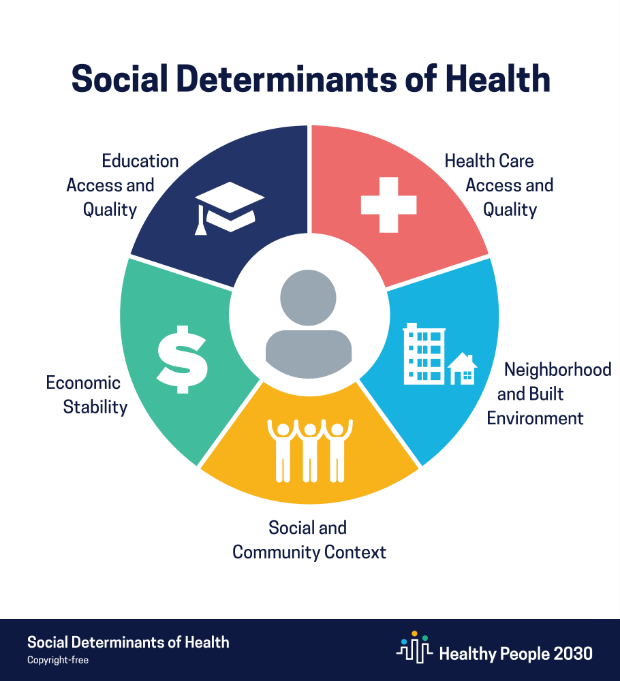How It All Started
This initiative was developed in response to an all too familiar story that was shared
about a patient who arrived frequently in need of hospital stays. After admission
and treatment her condition would improve, but she would be discharged only to return
for readmittance in a week or two. A deeper conversation followed by a home visit
revealed that the patient could not read and did not understand how to take her medication
appropriately. The story demonstrates the importance of patient-provider communication
and patient health literacy on health outcomes. You can read the full story here. This work was funded initially by The Duke Endowment grant #6816-SP from 2019-2022.
What Is Health Literacy
Health literacy is “the degree to which individuals can obtain, process and understand the basic health information and services they need to make appropriate health decisions.”1,2 Unfortunately, millions of adult Americans lack adequate health literacy skills. According to the National Assessment of Adult Literacy, only 12% of adults have proficient health literacy skills in the United States.3 This means 9 out of 10 adults may not possess adequate and appropriate skills needed to address their health.
This is especially concerning as health literacy is considered to be a stronger predictor of an individual’s health status than other socioeconomic factors such as age, education, employment, and income.2,4
In fact, limited health literacy is directly linked to increased rates of hospitalization, increased health care costs, and poor health, as well as feelings of shame and stigma from not being able to read, understand, and communicate about one’s health.5,6,7 Patients with poor health literacy use healthcare services frequently leading to increased healthcare costs.8 Individuals with limited health literacy may also have less knowledge about their condition resulting in difficulty managing treatment and care plans.9
Oftentimes, medical information is communicated in technical language which can negatively impact patient-provider communication.10 Improving patient health literacy and patient-provider communication is key in decreasing repeat medical visits, enhancing patient experiences and health outcomes, and decreasing healthcare provider burden.11,12
This video by the American Medical Association demonstrates the importance of clear communication
between patients and providers.
What are the Social Determinants of Health
Health People 2030 defines social determinants of health (SDoH) as “the conditions in the environments where people are born, live, learn, work, play, worship, and age that affect a wide range of health, functioning, and quality-of-life outcomes and risks”. These are categorized into five domains: Economic Stability, Education Access and Quality, Health Care Access and Quality, Neighborhood and Built Environment, and Social and Community Context. Within these domains are several potential risk and protective factors for health and mental health outcomes relating to access, quality, and safety of material, social, educational, occupational, civic, and health-related resources13. Health should be considered holistically, as it is both influenced by and influences patients’ lifestyles, resources, and behaviors. Thus, inclusion of patient SDoH in the medical encounter is crucial for understanding the non-medical factors impacting patients’ health and effectively addressing these barriers or needs.

References
- U.S. Department of Health and Human Services. (n.d.). Healthy People 2020. Retrieved October 29, 2019, from https://www.healthypeople.gov/.
- Parker, R.M., et al., Committee on Health Literacy for the Council on Scientific Affairs. (1999). Health literacy: Report of the Council on Scientific Affairs. JAMA, 281, 552-7.
- U.S. Department of Health and Human Services. (2008). America's Health Literacy: Why We Need Accessible Health Information. Retrieved October 20, 2019.
- Quinlan, P., Price, K. O., Magid, S. K., Lyman, S., Mandl, L. A., & Stone, P. W. (2013). The relationship among health literacy, health knowledge, and adherence to treatment in patients with rheumatoid arthritis. HSS Journal: The Musculoskeletal Journal of Hospital for Special Surgery, 9(1), 42-49.
- Baker, D. W., Gazmararian, J. A., Williams, M. V., Scott, T., Parker, R. M., Green, D., ... & Peel, J. (2002). Functional health literacy and the risk of hospital admission among Medicare managed care enrollees. American Journal of Public Health, 92(8), 1278-1283.
- Berkman, N. D., Sheridan, S. L., Donahue, K. E., Halpern, D. J., Viera, A., Crotty, K., ... & Tant, E. (2011). Health literacy interventions and outcomes: an updated systematic review. Evidence Report Technology Assessment (Full Rep), 199(1), 941.
- Easton, P., Entwistle, V. A., & Williams, B. (2013). How the stigma of low literacy can impair patient-professional spoken interactions and affect health: insights from a qualitative investigation. BMC Health Services Research, 13(1), 319.
- MacLeod, S., Musich, S., Gulyas, S., Cheng, Y., Tkatch, R., Cempellin, D., ... & Yeh, C. S. (2017). The impact of inadequate health literacy on patient satisfaction, healthcare utilization, and expenditures among older adults. Geriatric Nursing, 38(4), 334-341.
- Schillinger, D., Piette, J., Grumbach, K., Wang, F., Wilson, C., Daher, C., ... & Bindman, A. B. (2003). Closing the loop: physician communication with diabetic patients who have low health literacy. Archives of Internal Medicine, 163(1), 83-90.
- Choi, S. K., Seel, J. S., Yelton, B., Steck, S. E., McCormick, D. P., Payne, J., ... & Friedman, D. B. (2018). Prostate cancer information available in health-care provider offices: An analysis of content, readability, and cultural sensitivity. American Journal of Men's Health, 12(4), 1160-1167.
- Aoki, T., & Inoue, M. (2017). Association between health literacy and patient experience of primary care attributes: a cross-sectional study in Japan. PlOS ONE, 12(9), e0184565.
- Westlake, C., Sethares, K., & Davidson, P. (2013). How can health literacy influence outcomes in heart failure patients? Mechanisms and interventions. Current Heart Failure Reports, 10(3), 232-243.
- Office of Disease Prevention and Health Promotion. Social determinants of health (n.d.). Available online at: https://health.gov/healthypeople/objectives-and-data/browse-objectives#social-determinants-of-health
